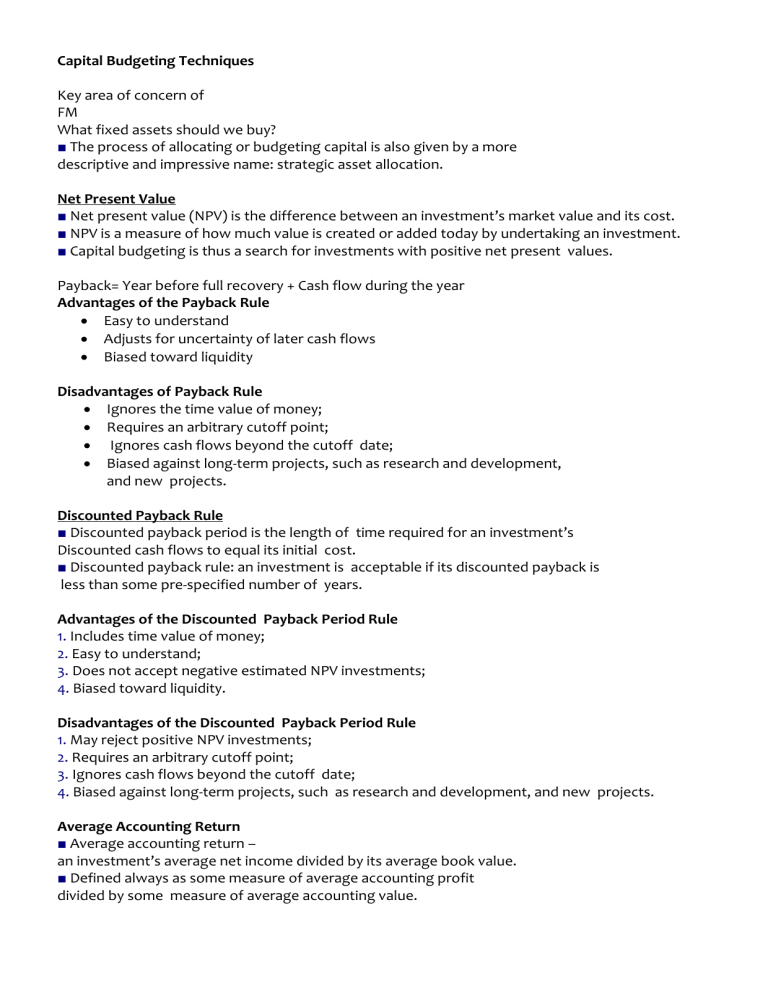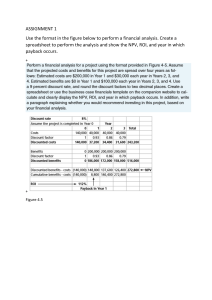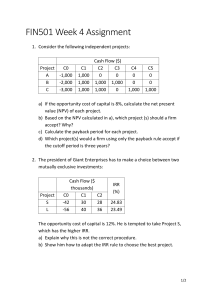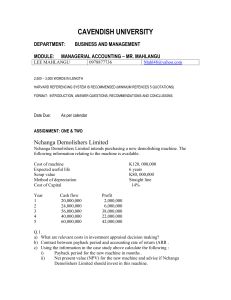
Capital Budgeting Techniques Key area of concern of FM What fixed assets should we buy? ■ The process of allocating or budgeting capital is also given by a more descriptive and impressive name: strategic asset allocation. Net Present Value ■ Net present value (NPV) is the difference between an investment’s market value and its cost. ■ NPV is a measure of how much value is created or added today by undertaking an investment. ■ Capital budgeting is thus a search for investments with positive net present values. Payback= Year before full recovery + Cash flow during the year Advantages of the Payback Rule Easy to understand Adjusts for uncertainty of later cash flows Biased toward liquidity Disadvantages of Payback Rule Ignores the time value of money; Requires an arbitrary cutoff point; Ignores cash flows beyond the cutoff date; Biased against long-term projects, such as research and development, and new projects. Discounted Payback Rule ■ Discounted payback period is the length of time required for an investment’s Discounted cash flows to equal its initial cost. ■ Discounted payback rule: an investment is acceptable if its discounted payback is less than some pre-specified number of years. Advantages of the Discounted Payback Period Rule 1. Includes time value of money; 2. Easy to understand; 3. Does not accept negative estimated NPV investments; 4. Biased toward liquidity. Disadvantages of the Discounted Payback Period Rule 1. May reject positive NPV investments; 2. Requires an arbitrary cutoff point; 3. Ignores cash flows beyond the cutoff date; 4. Biased against long-term projects, such as research and development, and new projects. Average Accounting Return ■ Average accounting return – an investment’s average net income divided by its average book value. ■ Defined always as some measure of average accounting profit divided by some measure of average accounting value. Average Accounting Return ■ AAR = average net income / average book value ■ AAR Rule: a project is acceptable if its average accounting return exceeds a target average accounting return Advantages of AAR 1. Easy to calculate; 2. Needed information will usually be available. Disadvantages of AAR 1. Not a true rate of return; time value of money is ignored; 2. Uses an arbitrary benchmark cutoff rate; 3. Based on accounting (book) values, not cash flows and market values. Internal Rate of Return Internal Rate of Return (IRR) - Discount rate at which NPV = 0. Rate of Return Rule - Invest in any project offering a rate of return that is higher than the opportunity cost of capital. Internal Rate of Return Pitfall 1 - Mutually Exclusive Projects ■ IRR sometimes ignores the magnitude of the project. Pitfall 2 - Lending or Borrowing? ■ With some cash flows (as noted below) the NPV of the project increases as the discount rate increases. ■ This is contrary to the normal relationship between NPV and discount rates. Pitfall 3 - Multiple Rates of Return ■ Certain cash flows can generate NPV=0 at two different discount rates e.g., projects with nonnormal cash flows Project Interactions When you need to choose between mutually exclusive projects, the decision rule is simple. Calculate the NPV of each project, and, from those options that have a positive NPV, choose the one whose NPV is highest. Investment Timing Sometimes you have the ability to defer an investment and select a time that is more ideal at which to make the investment decision. A common example involves a tree farm. You may defer the harvesting of trees. By doing so, you defer the receipt of the cash flow, yet increase the cash flow. ■ Capital rationing occurs when a company experiences a shortage of funds and is forced to choose between worthwhile projects ■ When capital is rationed the company needs a method of selecting the package of projects that is within the company’s resources and at the same time provides the highest possible net present value Types of Capital Rationing ■ Soft rationing occurs as a result of provisional limits adopted by management as an aid to financial control and are not due to imperfections in capital markets. Soft rationing should never cost the company anything. ■ Hard rationing results when the company cannot raise enough financial resources to undertake all projects with high positive NPVs, which implies market imperfections. ■ Capital is not the only limited resource in project analysis and even when there is access to additional capital, other resources may be limited Availability of management time, skilled labor, or capital equipment often limits a company’s growth In simpler terms… Capital Rationing - Limit set on the amount of funds available for investment. Soft Rationing - Limits on available funds imposed by management. Hard Rationing - Limits on available funds imposed by the unavailability of funds in the capital market. Conclusions Mathematically, the NPV, IRR, MIRR, and PI methods will always lead to the same accept/reject decisions for independent projects: If a project’s NPV is positive, its IRR and MIRR will always exceed k, and its PI will always be greater than 1.0. However, these methods can give conflicting rankings for mutually exclusive projects. Most large firms consider all of these measures, because each one provides decision makers with somewhat different pieces of relevant information. Conclusions Payback and Discounted Payback -provides indication of both the risk and the liquidity of the a project: a long payback means that (1) the investment dollars will be locked up for many years, hence project is relatively illiquid, and that (2) the project’s ash flow must be forecasted far out into the future, hence the project is quite risky, re: bond valuation process (aside from YTM, consider also maturity) Net Present Value (NPV) -provides the best single measure of profitability, because it gives a direct measure of the dollar benefit of the project to shareholders Conclusions Internal Rate of Return (IRR) -also measures profitability, but here it is expressed as a percentage rate of return, which many decision makers prefer -provides “safety margin” information on cash flow forecasts or the amount of capital at risk that NPV neither provides Modified Internal Rate of Return (MIRR) -aside from having all the virtues of IRR, this method (1) incorporates a better reinvestment rate assumption, and (2) avoids the multiple rate of return problem (multiple IRRs) Conclusions Profitability Index (PI) -measures profitability relative to the cost of the project: it shows the “bang per buck” -like IRR, it gives an indication of the project’s risk e.g., a high PI means that cash flows could fall quite a bit and the project can still be profitable





